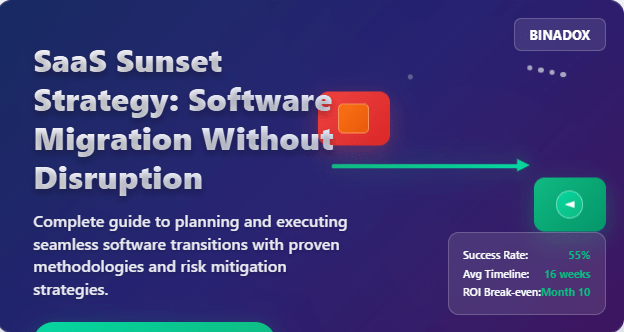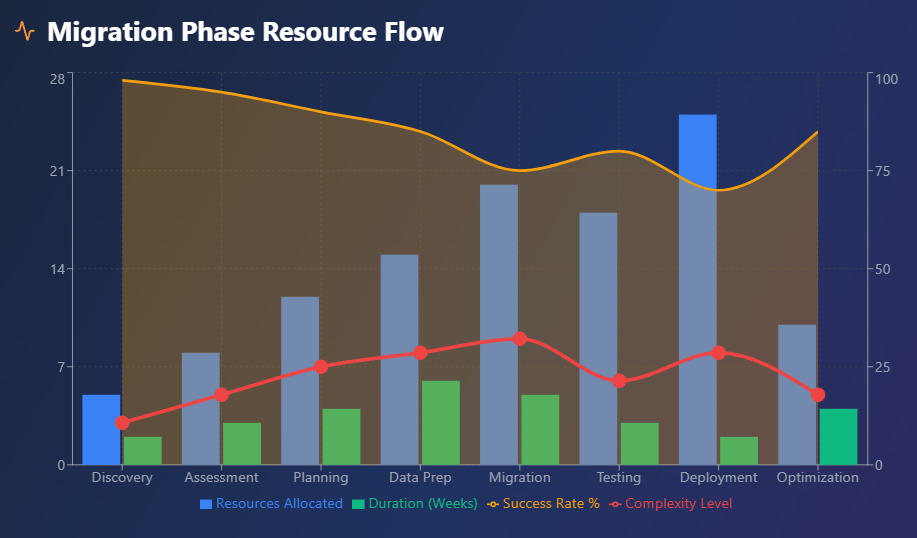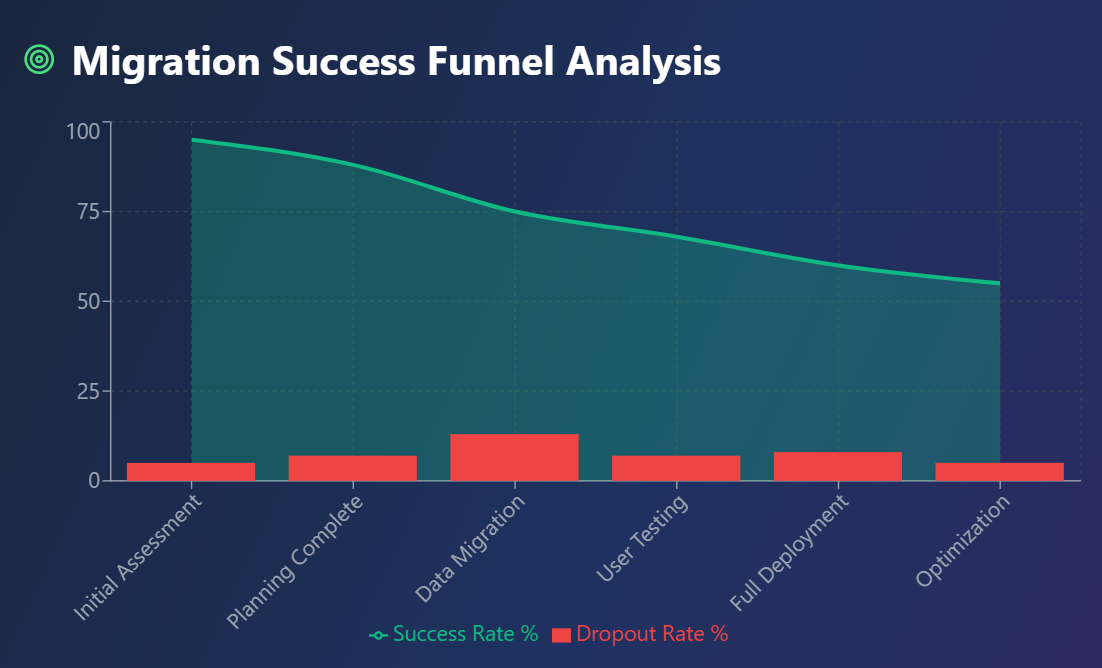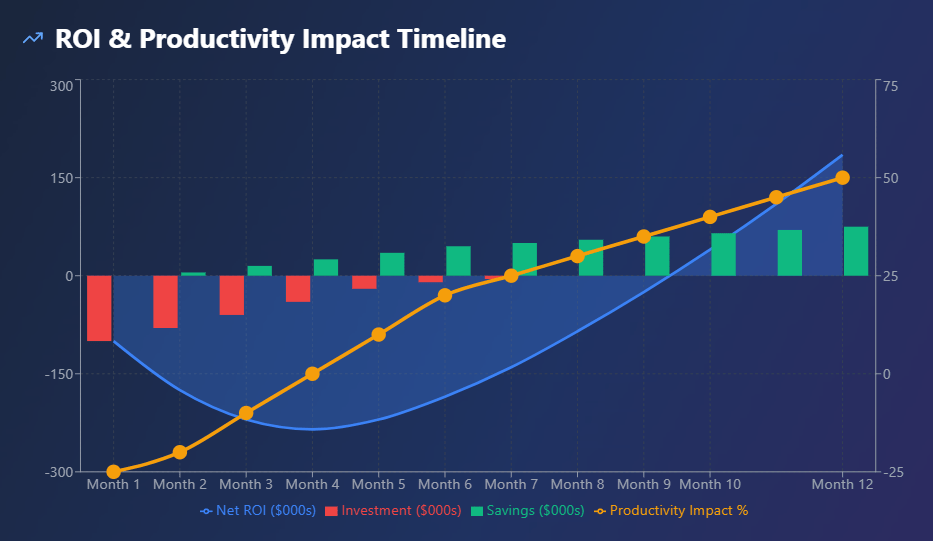
Software as a Service (SaaS) applications have become the backbone of modern business operations, but organizations frequently face the need to migrate from one platform to another due to evolving business requirements, cost considerations, or vendor changes. A well-structured SaaS sunset strategy ensures these transitions occur seamlessly without disrupting critical business operations.
The complexity of modern SaaS environments, where organizations typically manage 80+ applications on average, demands sophisticated migration planning. Without proper SaaS governance and strategic oversight, software transitions can result in data loss, productivity disruption, and unexpected costs that can impact business continuity for months.
This comprehensive guide examines proven methodologies for executing successful SaaS migrations while maintaining operational excellence. From initial assessment through post-migration optimization, we’ll explore the critical components that separate successful software transitions from costly disruptions.
What is a SaaS Sunset Strategy?
A SaaS sunset strategy is a structured approach to discontinuing one software solution while transitioning users, data, and business processes to an alternative platform. Unlike traditional software migrations, SaaS sunset strategies must account for cloud-based architectures, subscription models, and distributed user bases that characterize modern software as a service environments.
The strategy encompasses three critical phases: preparation and assessment, active migration execution, and post-transition optimization. Each phase requires careful coordination between IT teams, business stakeholders, and end users to ensure business continuity throughout the transition process.
Effective SaaS management during sunset scenarios involves more than technical migration—it requires comprehensive change management, risk assessment, and cost optimization strategies. Organizations must balance the urgency of completing transitions with the need to maintain service quality and user productivity.
Modern SaaS sunset strategies differ significantly from traditional software replacements because they involve subscription management complexities, integration dependencies, and cloud security considerations that weren’t present in on-premises environments. This evolution requires new approaches to planning and execution.
Why SaaS Sunset Strategies Matter
The financial impact of poorly executed SaaS transitions extends far beyond migration costs. Organizations experiencing failed software migrations report productivity losses averaging 20-30% during transition periods, with some business functions remaining impaired for months after implementation.
SaaS cost optimization becomes particularly critical during sunset scenarios because organizations often maintain dual subscriptions during transition periods. Without proper planning, these overlapping costs can represent significant budget strain, especially when combined with training, integration, and support expenses.
Data security and compliance requirements add another layer of complexity to SaaS sunset strategies. Organizations must ensure that sensitive information remains protected throughout migration processes while maintaining compliance with industry regulations and internal governance policies.
The interconnected nature of modern SaaS ecosystems means that changes to one application can impact multiple business processes. A comprehensive cloud management strategy helps organizations understand these dependencies and plan accordingly to minimize disruption.
User adoption challenges represent one of the most significant risks in SaaS migrations. Without proper change management and training programs, even technically successful migrations can fail to deliver expected business benefits, leading to reduced productivity and user satisfaction.
Pre-Migration Assessment and Planning
Successful software migration begins with comprehensive assessment of current systems, user requirements, and business processes. Organizations must evaluate not only the technical aspects of their existing SaaS solutions but also the business workflows, integrations, and dependencies that have developed around these platforms.
The assessment phase should include detailed analysis of data volumes, user access patterns, integration requirements, and compliance considerations. This information forms the foundation for migration timeline development and resource allocation decisions.
Application lifecycle management principles guide the assessment process by ensuring that organizations consider the full spectrum of factors affecting migration success. This includes evaluating vendor relationships, contract terms, and support arrangements that may impact transition timing and approaches.
Financial assessment involves analyzing current SaaS spend management patterns to understand the total cost of ownership for existing solutions compared to proposed replacements. This analysis should account for direct subscription costs, integration expenses, training investments, and productivity impact during transition periods.
Risk assessment identifies potential points of failure in migration plans and develops contingency strategies for addressing these challenges. Common risk factors include data compatibility issues, integration complexity, user resistance, and vendor support limitations.
Key Assessment Components
Data Inventory and Classification Organizations must catalog all data stored within sunset applications, classify information based on sensitivity and business criticality, and identify data relationships that may complicate migration processes.
Integration Mapping Modern SaaS applications rarely operate in isolation. Comprehensive integration mapping reveals connections between applications, APIs, and business processes that must be maintained or recreated during migration.
User Analysis Understanding how different user groups interact with existing applications helps inform training requirements, rollout strategies, and change management approaches that support successful adoption of replacement solutions.
Compliance Review Organizations must ensure that migration processes and destination platforms meet all relevant regulatory requirements and internal compliance standards without creating gaps in data protection or audit capabilities.
Building Your SaaS Migration Framework
A robust migration framework provides the structure and methodology needed to execute complex software transitions while maintaining business operations. The framework should address technical migration requirements, project management processes, and stakeholder communication strategies.
The foundation of effective migration frameworks lies in establishing clear governance structures that define roles, responsibilities, and decision-making authority throughout the transition process. This governance model should include representatives from IT, business units, compliance, and executive leadership.
SaaS governance policies must be adapted or created to address migration-specific requirements such as data handling procedures, security protocols, and vendor management practices. These policies provide consistent guidance for migration team members and ensure compliance with organizational standards.
Timeline development requires balancing the urgency of completing migrations with the practical constraints of data transfer, user training, and business process adaptation. Realistic scheduling accounts for both planned migration activities and unexpected challenges that commonly arise during complex transitions.
Communication planning ensures that all stakeholders remain informed about migration progress, potential impacts, and required actions. Effective communication strategies address different audiences with appropriate levels of detail and timing.

Migration Framework Components
Project Governance Structure Establish executive sponsorship, project management office oversight, and cross-functional teams responsible for different aspects of migration execution.
Technical Architecture Planning Define data migration approaches, integration requirements, security protocols, and testing procedures that ensure successful platform transitions.
Change Management Strategy Develop user communication plans, training programs, and support structures that facilitate smooth adoption of replacement applications.
Risk Management Process Implement monitoring and response procedures for identifying and addressing migration risks before they impact business operations.
Risk Mitigation and Continuity Planning
Risk mitigation in SaaS sunset strategies requires proactive identification of potential failure points and development of contingency plans that minimize business impact. The distributed nature of cloud-based applications creates unique risk scenarios that don’t exist in traditional software environments.
Business continuity planning must account for the possibility that migration timelines may extend beyond initial estimates or that unexpected compatibility issues may arise during transition processes. Contingency strategies should include procedures for maintaining operations using existing systems while addressing migration challenges.
Subscription management considerations become critical during risk planning because organizations must balance the cost of maintaining dual subscriptions against the risk of service interruption if migrations encounter delays. Strategic subscription timing can provide flexibility while controlling costs.
Data backup and recovery procedures take on heightened importance during SaaS migrations because organizations may lose access to historical data if migrations fail or if vendor relationships deteriorate. Comprehensive backup strategies ensure data availability regardless of migration outcomes.
Testing and validation procedures help identify potential issues before they impact production environments. Thorough testing should include not only functional verification but also performance, security, and integration validation across all affected systems.

Critical Risk Mitigation Strategies
Parallel Operation Planning Maintain existing systems in parallel with new platforms during initial migration phases to ensure business continuity if issues arise.
Data Recovery Preparation Implement comprehensive data backup and export procedures before beginning migration activities to ensure information availability if recovery becomes necessary.
Vendor Relationship Management Maintain positive relationships with existing vendors throughout migration processes to ensure continued support and potential collaboration if challenges arise.
User Support Escalation Develop rapid response procedures for addressing user issues and concerns that may arise during migration periods.
Data Migration and Security Considerations
Data migration represents one of the most critical and complex aspects of SaaS sunset strategies. Organizations must ensure that information transfers between platforms maintain data integrity, security, and compliance while minimizing the risk of data loss or corruption.
Cloud security considerations during data migration extend beyond traditional backup and recovery procedures because information often traverses multiple cloud environments and third-party systems during transition processes. Security protocols must address data in transit, at rest, and during processing phases.
Data mapping and transformation requirements can significantly impact migration complexity and timeline. Organizations must understand how data structures, formats, and relationships differ between existing and replacement platforms to develop appropriate conversion strategies.
Compliance requirements may dictate specific data handling procedures during migration processes. Organizations operating in regulated industries must ensure that data migration approaches meet all relevant standards while maintaining audit trails and documentation requirements.
Access control and permission management become particularly important during migration periods when users may need access to both old and new systems simultaneously. Clear protocols prevent unauthorized access while ensuring appropriate user permissions.
Data Security Best Practices
Encryption and Protection Implement end-to-end encryption for all data transfers and ensure that information remains protected throughout migration processes.
Access Monitoring Track all data access and modification activities during migration periods to maintain security oversight and compliance documentation.
Validation and Verification Implement comprehensive data validation procedures to ensure that information transfers correctly and completely between platforms.
Compliance Documentation Maintain detailed records of all data handling activities to support compliance auditing and regulatory reporting requirements.
Cost Optimization During SaaS Transitions
SaaS cost optimization during sunset scenarios requires careful balance between maintaining business operations and controlling transition expenses. Organizations often face pressure to complete migrations quickly while simultaneously managing budgets that may not account for dual subscription costs and migration-related expenses.
Strategic timing of subscription renewals and cancellations can significantly impact migration costs. Organizations should coordinate migration timelines with contract renewal dates to minimize overlap periods and negotiate favorable terms for transition scenarios.
SaaS spend management tools become particularly valuable during migration periods because they provide visibility into actual usage patterns and costs across both existing and replacement applications. This visibility enables data-driven decisions about resource allocation and timeline optimization.
Hidden costs often emerge during SaaS migrations, including integration development, data conversion services, additional user training, and extended support requirements. Comprehensive budgeting should account for these potential expenses to avoid budget overruns.
Vendor negotiations may provide opportunities for cost reduction during migration periods. Organizations can leverage their transition scenarios to negotiate better pricing, extended trial periods, or additional services from both existing and replacement vendors.
Cost Optimization Strategies
Subscription Timing Coordination Align migration timelines with contract renewal dates to minimize overlapping subscription costs and maximize negotiation opportunities.
Resource Utilization Monitoring Track actual usage patterns across both existing and replacement applications to optimize subscription levels and feature requirements.
Training Investment Planning Balance comprehensive user training requirements with budget constraints by prioritizing training for critical user groups and processes.
Vendor Partnership Leverage Work with both existing and replacement vendors to identify opportunities for cost reduction, extended support, or value-added services.
Organizations implementing cloud cost optimization strategies often discover that migration periods provide opportunities for broader cost reduction through improved vendor relationships and more strategic subscription management.

Change Management and User Adoption
User adoption challenges represent the most common cause of SaaS migration failures, even when technical implementations proceed smoothly. Successful change management requires understanding user concerns, providing adequate training and support, and creating positive incentives for embracing new platforms.
Communication strategies must address different stakeholder groups with appropriate messaging, timing, and detail levels. Executive communications focus on strategic benefits and business alignment, while end-user communications emphasize practical benefits and support availability.
Training program development should account for different learning styles, experience levels, and job requirements across user populations. Effective training combines formal instruction with hands-on practice and ongoing support resources.
Software vendor management relationships can provide valuable support during user adoption phases. Many SaaS vendors offer specialized change management resources, training materials, and support services designed specifically for migration scenarios.
Feedback collection and response mechanisms help organizations address user concerns proactively and demonstrate commitment to successful adoption. Regular pulse surveys and support metrics provide insights into adoption progress and emerging challenges.
Change Management Best Practices
Stakeholder Engagement Involve key users in migration planning and decision-making processes to build ownership and reduce resistance to change.
Phased Rollout Strategy Implement migrations in phases that allow for learning and adjustment based on early user experiences and feedback.
Support Resource Planning Provide adequate help desk, training, and documentation resources to support users throughout transition periods.
Success Metrics Tracking Monitor adoption rates, user satisfaction, and productivity metrics to measure change management effectiveness and identify improvement opportunities.
Post-Migration Optimization
Post-migration optimization ensures that organizations realize the full benefits of their SaaS transitions while addressing any remaining challenges or opportunities for improvement. This phase focuses on performance tuning, user experience enhancement, and long-term value realization.
Application lifecycle management practices guide post-migration activities by establishing ongoing monitoring, maintenance, and optimization procedures that support continued platform effectiveness. Regular assessment and adjustment ensure that applications continue meeting evolving business requirements.
Integration optimization often reveals opportunities for process improvement and automation that weren’t apparent during initial migration planning. Organizations should conduct comprehensive integration reviews to identify these optimization opportunities.
User feedback analysis provides insights into adoption challenges, training gaps, and feature utilization patterns that inform ongoing optimization efforts. Regular feedback collection helps organizations address issues before they impact productivity or satisfaction.
Cost monitoring and optimization continue beyond initial migration completion because usage patterns and requirements often evolve as users become more familiar with new platforms. Ongoing SaaS spend management ensures continued cost effectiveness.
Optimization Focus Areas
Performance Monitoring Track application performance, user response times, and system availability to ensure optimal platform operation.
Feature Utilization Analysis Monitor which features and capabilities users actually employ to optimize subscription levels and identify training opportunities.
Integration Enhancement Identify opportunities for improving data flow, automation, and process integration based on actual usage patterns.
Ongoing Cost Management Continuously monitor and optimize subscription costs based on actual usage patterns and changing business requirements.
Common Pitfalls and How to Avoid Them
Understanding common migration pitfalls helps organizations avoid costly mistakes and delays that can undermine software migration success. Many failures stem from inadequate planning, unrealistic timelines, or insufficient attention to change management requirements.
Underestimating data complexity represents one of the most frequent migration challenges. Organizations often discover unexpected data relationships, format incompatibilities, or volume constraints that weren’t apparent during initial assessments.
SaaS governance failures commonly occur when organizations don’t establish clear authority and decision-making processes for migration activities. Without proper governance, migration teams may struggle with competing priorities, unclear requirements, or inadequate resources.
Timeline pressure often leads organizations to skip important planning or testing activities, increasing the risk of migration failures or business disruption. Realistic scheduling that accounts for complexity and potential challenges produces better outcomes than overly aggressive timelines.
Vendor relationship management mistakes can create unnecessary complications during migration processes. Organizations should maintain professional relationships with existing vendors while building partnerships with replacement providers.
Key Pitfalls to Avoid
Insufficient Testing Conduct comprehensive testing across all integration points, user scenarios, and data migration processes before production implementation.
Inadequate Training Provide sufficient training time and resources to ensure user confidence and competence with replacement applications.
Poor Communication Maintain clear, consistent communication with all stakeholders throughout migration processes to prevent confusion and resistance.
Rushed Implementation Allow adequate time for proper planning, testing, and gradual rollout rather than forcing unrealistic timelines that increase risk.
Leveraging SaaS Management Tools
SaaS management tools provide essential visibility and control capabilities that support successful migration planning and execution. These platforms help organizations understand their current application environments, monitor migration progress, and optimize post-transition operations.
Comprehensive SaaS discovery capabilities reveal the full scope of applications and integrations that may be affected by migration activities. Many organizations discover previously unknown applications or dependencies during systematic discovery processes.
Subscription management features help organizations coordinate timing, costs, and contract considerations across multiple platforms during transition periods. Automated tracking and alerting prevent missed renewals or contract deadlines that could complicate migration efforts.
Usage analytics provide insights into actual application utilization patterns that inform migration prioritization and resource allocation decisions. Understanding which applications and features users actually employ helps organizations focus migration efforts on business-critical capabilities.
Cost analysis and optimization features support ongoing SaaS cost optimization efforts throughout migration processes and beyond. Real-time cost visibility enables data-driven decisions about subscription levels, feature requirements, and vendor negotiations.
Organizations seeking comprehensive SaaS management capabilities should consider platforms like Binadox that provide integrated discovery, monitoring, and optimization capabilities specifically designed for complex SaaS environments.
SaaS Management Tool Benefits
Comprehensive Visibility Gain complete understanding of application landscapes, usage patterns, and cost structures that inform migration planning.
Automated Monitoring Track migration progress, identify issues, and monitor performance across all affected applications and integrations.
Cost Optimization Identify opportunities for cost reduction, subscription optimization, and vendor consolidation throughout migration processes.
Compliance Support Maintain documentation, audit trails, and compliance monitoring capabilities that support regulatory requirements.
Conclusion
Successful SaaS sunset strategies require comprehensive planning, strategic execution, and ongoing optimization to achieve migration objectives without disrupting business operations. Organizations that invest in proper assessment, framework development, and change management consistently achieve better outcomes with lower costs and reduced risk.
The complexity of modern SaaS environments demands sophisticated approaches to software migration that account for technical, financial, and organizational factors. Traditional migration methodologies must evolve to address cloud-based architectures, subscription models, and distributed user bases that characterize contemporary software environments.
SaaS governance and management capabilities provide the foundation for successful migration execution by ensuring visibility, control, and optimization throughout transition processes. Organizations lacking these capabilities face significantly higher risks of migration failures, cost overruns, and business disruption.
The investment in proper migration planning and execution pays dividends through improved application performance, enhanced user satisfaction, and optimized costs that support long-term business success. Organizations that view SaaS sunset strategies as strategic initiatives rather than tactical projects consistently achieve better results and return on investment.
As SaaS optimization and management continue evolving, organizations must develop internal capabilities and partner relationships that support ongoing platform transitions and optimization efforts. The ability to execute successful software migrations has become a core competency for modern businesses operating in cloud-centric environments.
By implementing the strategies and best practices outlined in this guide, organizations can navigate complex SaaS transitions with confidence while maintaining operational excellence and achieving strategic objectives. The key to success lies in thorough preparation, realistic planning, and commitment to both technical excellence and organizational change management throughout the migration process.
Effective SaaS spend management and strategic migration planning enable organizations to harness the full potential of cloud-based software solutions while minimizing risk and controlling costs. Organizations that master these capabilities position themselves for continued success in an increasingly software-driven business environment.

